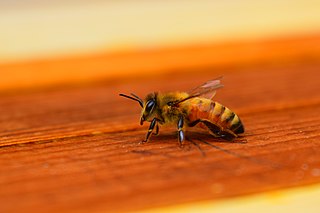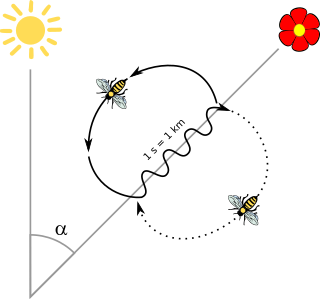
Humanities are academic disciplines that study aspects of human society and culture, including certain fundamental questions asked by humans. During the Renaissance, the term 'humanities' referred to the study of classical literature and language, as opposed to the study of religion or 'divinity.' The study of the humanities was a key part of the secular curriculum in universities at the time. Today, the humanities are more frequently defined as any fields of study outside of natural sciences, social sciences, formal sciences, and applied sciences. They use methods that are primarily critical, speculative, or interpretative and have a significant historical element—as distinguished from the mainly empirical approaches of science.

A honey bee is a eusocial flying insect within the genus Apis of the bee clade, all native to mainland Afro-Eurasia. After bees spread naturally throughout Africa and Eurasia, humans became responsible for the current cosmopolitan distribution of honey bees, introducing multiple subspecies into South America, North America, and Australia.

Jan or Johannes Swammerdam was a Dutch biologist and microscopist. His work on insects demonstrated that the various phases during the life of an insect—egg, larva, pupa, and adult—are different forms of the same animal. As part of his anatomical research, he carried out experiments on muscle contraction. In 1658, he was the first to observe and describe red blood cells. He was one of the first people to use the microscope in dissections, and his techniques remained useful for hundreds of years.

Karl Ritter von Frisch, was a German-Austrian ethologist who received the Nobel Prize in Physiology or Medicine in 1973, along with Nikolaas Tinbergen and Konrad Lorenz.

Bee learning and communication includes cognitive and sensory processes in all kinds of bees, that is the insects in the seven families making up the clade Anthophila. Some species have been studied more extensively than others, in particular Apis mellifera, or European honey bee. Color learning has also been studied in bumblebees.
The Graduate School and University Center of the City University of New York is a public research institution and postgraduate university in New York City. Serving as the principal doctorate-granting institution of the City University of New York (CUNY) system, The CUNY Graduate Center is classified among "R1: Doctoral Universities – Very High Research Activity". The school is located at the B. Altman and Company Building at 365 Fifth Avenue in Midtown Manhattan. The CUNY Graduate Center offers 31 doctoral programs, 14 master's programs, and 30 research centers and institutes. It employs a core faculty of approximately 140, who are supplemented by 1,800 faculty members from CUNY's eleven senior colleges and New York City's cultural and scientific institutions. As of June 2024, the Graduate Center enrolls 3,228 students, of which 2,621 or 81% are doctoral students.

Jilin University (JLU) is a public university in Changchun, Jilin, China. It is affiliated with the Ministry of Education. The university is part of Project 211, Project 985, and the Double First-Class Construction.

The University of Science and Technology of China (USTC) is a public university in Hefei, China. It is affiliated with the Chinese Academy of Sciences, and co-funded by the Chinese Academy of Sciences, the Ministry of Education of China, and the Anhui Provincial Government.

Osaka University, abbreviated as OU or Handai (阪大), is a national research university in Osaka, Japan. The university traces its roots back to Edo-era institutions Tekijuku (1838) and Kaitokudo (1724), and was officially established in 1931 as the sixth of the Imperial Universities in Japan, with two faculties: science and medicine. Following the post-war educational reform, it merged with three pre-war higher schools, reorganizing as a comprehensive university with five faculties: science, medicine, letters, law and economics, and engineering. After the merger with Osaka University of Foreign Studies in 2007, Osaka University became the largest national university in Japan by undergraduate enrollment.

Waggle dance is a term used in beekeeping and ethology for a particular figure-eight dance of the honey bee. By performing this dance, successful foragers can share information about the direction and distance to patches of flowers yielding nectar and pollen, to water sources, or to new nest-site locations with other members of the colony.
The American Council of Learned Societies (ACLS) is a private, nonprofit federation of 75 scholarly organizations in the humanities and related social sciences founded in 1919. It is best known for its fellowship competitions which provide a range of opportunities for scholars in the humanities and related social sciences at all career stages, from graduate students to distinguished professors to independent scholars, working with a number of disciplines and methodologies in the U.S. and abroad.
The Canadian Federation for the Humanities and Social Sciences, also known as the Federation for the Humanities and Social Sciences, is a member-based organization and the national voice for researchers in the humanities and social sciences in Canada. Formed in 1996 through a merger of the Social Science Federation of Canada and the Canadian Federation for the Humanities, it is a non-profit charitable organization that represents more than 85,000 researchers in 81 scholarly associations, 80 universities and colleges, and 6 affiliates across the country.

Digital humanities (DH) is an area of scholarly activity at the intersection of computing or digital technologies and the disciplines of the humanities. It includes the systematic use of digital resources in the humanities, as well as the analysis of their application. DH can be defined as new ways of doing scholarship that involve collaborative, transdisciplinary, and computationally engaged research, teaching, and publishing. It brings digital tools and methods to the study of the humanities with the recognition that the printed word is no longer the main medium for knowledge production and distribution.

Project MUSE, a non-profit collaboration between libraries and publishers, is an online database of peer-reviewed academic journals and electronic books. Project MUSE contains digital humanities and social science content from some 400 university presses and scholarly societies around the world. It is an aggregator of digital versions of academic journals, all of which are free of digital rights management (DRM). It operates as a third-party acquisition service like EBSCO, JSTOR, OverDrive, and ProQuest.

Konkuk University is a South Korean private university founded in 1931 and it is one of the top universities in South Korea. The university was founded based on three virtues: sincerity, fidelity, and righteousness.

The western honey bee or European honey bee is the most common of the 7–12 species of honey bees worldwide. The genus name Apis is Latin for "bee", and mellifera is the Latin for "honey-bearing" or "honey carrying", referring to the species' production of honey.
Tariq Rahman is a Pakistani academic scholar, newspaper columnist, researcher, and a writer.
This prize should not be confused with the Watson Davis Award from the Association for Information Science and Technology.
The Watson Davis and Helen Miles Davis Prize of the History of Science Society is awarded yearly for a book published, during the past three years, on the history of science for a wide public. The book should "introduce an entire field, a chronological period, a national tradition, or the work of a noteworthy individual." The book can be written by multiple authors or editors and is required to be written in English and suitable for an audience including undergraduates and readers without specialized, technical knowledge. The author receives 1,000 U.S. dollars and a certificate. The prize, established in 1985, is named in honor of Watson Davis and Helen Miles Davis who were science popularizers in the USA.

Martin Giurfa is an Argentinean-French neurobiologist and neuroethologist, member of the German National Academy of Sciences Leopoldina, the Académie royale des sciences, des lettres et des beaux-arts de Belgique, and the Institut Universitaire de France (IUF). He is acknowledged for his work on the neural mechanisms of cognition in invertebrates, which he mostly explores using honeybees as models for understanding basic principles of learning and memory.













